DATA - This week the 60th Eurovision Song Contest is held in Vienna. An event watched by millions all over the world.
We’ve analyzed the last 40 years, from 1975 to 2014, to see if the proximity of countries has any influence on the voting. Our conclusion: yes, it does.
What we did was calculating the distance between all the capitals of the countries that participated (or voted) in the last 40 years. Why that period? Because in 1975 the current voting system was introduced. So these years can be compared.
Next we calculated how many points a particular country gave to another country and divided that by the times they voted. If they gave no points but could have, a zero was used.
And then we plotted these date in a graph. On the horizontal bar the distance between the capitals. On the vertical bar the average points given (in finals and semi-finals).
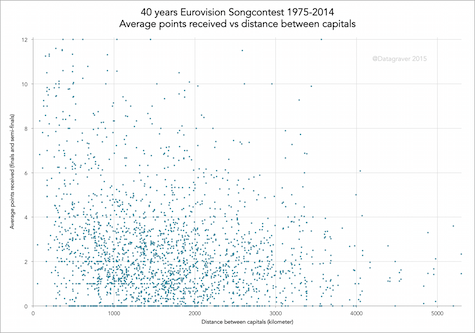
So? Is there a trend? If you look hard, you can see more points higher up on the left hand side. But it’s difficult. So we add a simple, linear, trend line.
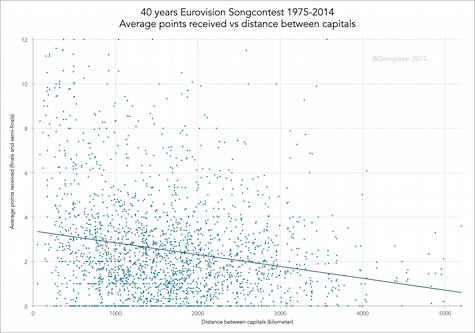
Based on this, the conclusion could be that countries that are closest to each other give roughly three times as many points than countries far away from each other.
But since this is a very crude way of plotting a trend, we’ve also did one with a so called order 6 polynomial trend line. Then you get this:
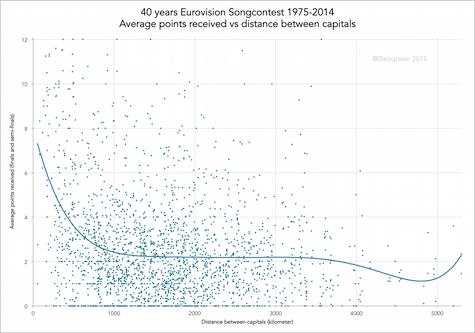
This shows that the favorites effect is strongest in the first 1.000 kilometers from home. After that it wanes.
But the conclusion stands. The closer countries are, the higher the points.
You can have a closer look per country in the following visualization. Select Greece or Ukraine for the best effect (box in the upper right corner):
A direct link to this viz gives you a full screen version.
And while we were at it, we also created a matrix with all the averages between countries. This time only for all the finals.
You can use it to predict Saturday’s outcome.
Please not, if you click on it, the full version is over 2Mb.
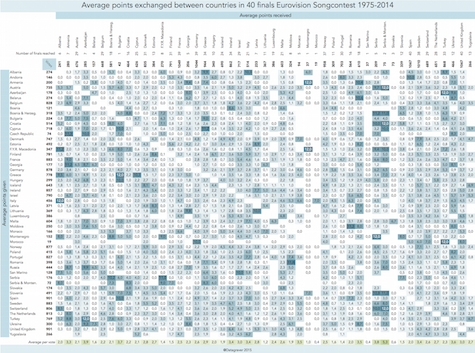
And last but not least, because we had the data anyway, a list of countries that participated in at least 10 finals order by the average points they got for all votes received.
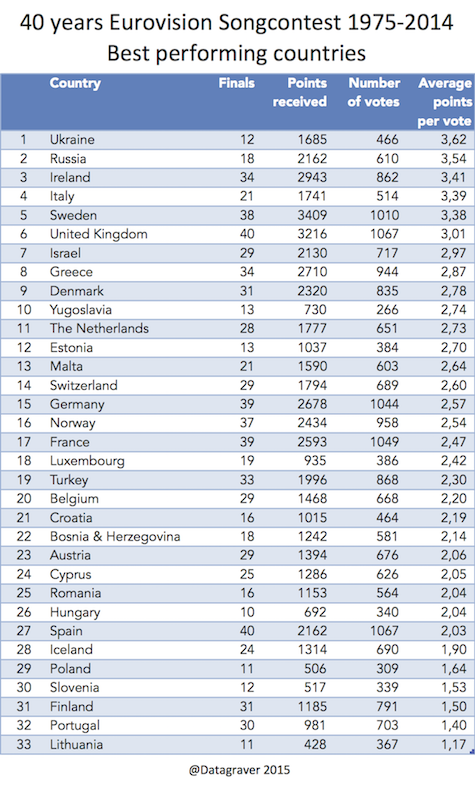
Let’s see if the upcoming finale changes the order.
NB: No contestants were harmed during the making of this post.

Reacties (23)
The closer countries are, the higher the points.
Eigenlijk is het dus out of order dat Ierland 7 keer gewonnen heeft waarvan 6 keer met de bedoelde telling.
Had je niet even een native speaker over je tekst kunnen laten gaan….
Moldavië en Servië zijn bijzonder schaamteloos.
Dat zal wel een lastig en tijdrovend onderzoek zijn geweest, om uit te vinden wat ieder kind 30 jaar geleden ook al wist. Hun volgend onderzoek zal gaan over de stelling dat iemand die in een auto zit die 120 rijdt in een uur verder komt dan iemand die een uur lang stil staat.
Some distances between capitals may be more frequent than others, e.g. there may be more pairs of capitals that are about a thousand kilometers apart, than there are pairs of capitals that are about three thousand kilometers apart. In that case, it wouldn’t be surprising that countries give more points to other countries that are about a thousand kilometers away, than they give points to other countries that are about three thousand kilometers away. So, it seems the scores need to be corrected for the expected distribution, given the frequency of particular distances.
Ten eerste is dit natuurlijk niet verrassend. Landen die dicht bij elkaar liggen hebben vaak een (liedjes-)cultuur die ook dicht bij elkaar ligt.
Daarnaast is het idee van de hoofdsteden zeker voor grote landen nogal vreemd. Sommige landen hebben in bepaalde streken grote etnische groepen die sterke banden hebben met een buurland, terwijl die groepen niet dicht bij de hoofdstad wonen. Neem bijvoorbeeld de Hongaars-sprekenden in Roemenie en de Russen in diverse voormalige USSR-landen.
If the conclusion is right, then that means that countries with more neighboring countries close by are more likely to win: they have more other countries within close range. So, countries in the center of Europe would stand a bigger chance (that would include last years winner Austria of course). Looking at the list of results, I notice that in the list of results only two of the top ten countries can be considered “central” in Europe. The others are more in the periphery it seems (Ireland for instance).
I think the conclusion is rather weak.
@3
Ik zie niet in wat daar schaamteloos aan is. Mensen vinden nou eenmaal eerder muziek mooi die uit een cultuur komt die dicht bij hun eigen cultuur staat.
@4: Dat is een uitspraak in de categorie “wetenschap is overbodig, ik voel zelf toch wel dat er zwaartekracht is” :-)
Hoe vanzelfsprekend sommige zaken ook lijken, het is soms nog verdomd lastig om dat ook te bewijzen.
@7: An average over 40 years can’t predict a single outcome. And in the average the semi-finales are included as well.
But I’ll try to see if I can find a relation between end positions and the average distance to other countries.
@2: Nee, die hebben we niet in de redactie en er was geen tijd. Maar correcties voer ik graag door.
@6: De hoofdsteden zijn enerzijds gekozen omdat bij het stemmen steeds geroepen wordt “Hello London, may we have your votes please”. Anderzijds omdat het zoeken naar het geografische middelpunt van ieder land te lang duurde en minstens net zo arbitrair is.
Ik ben benieuwd of Azerbeidjan en Georgië (schijnen tegenwoordig ook bij Europa te horen, net als Israël) elkaar veel punten geven. En hoeveel punten deze landjes aan grote zus Rusland gaan geven.
De punten, die Australië gaat geven, kunnen we buiten beschouwing laten. De afstand tussen Australië en andere deelnemende landen is belachelijk groot.
Maak je zondag nog een update, Steeph?
De gustibus non est disputandum maar over de puntentoekenning kun je werkelijk oneindig disputeren.
Nu heb ik het songfestival altijd al een vorm “beeldbuisvervuiling” gevonden, maar dat ge-oh erover is zeker zo erg.
;-)
N.B.
Indien die statistiekjes, voorzien van wat kleur, door een “twirlfilter” in photoshop worden gehaald, leveren ze vast wat leuke plaatjes op :-)
@8: Ik kan me nauwelijks voorstellen dat een gedeelde muziekcultuur de oorzaak is van het verschijnsel. Ik denk eerder aan nationalistische/etnische gevoelens of economische belangen.
Steeph,
Currently you use the geographical distance. How about if you use the ‘degree of separation’, i.e. the amount of countries in between. So D-NL has a distance of 0, F-NL has ha distance of 1 (B) etc, etc. (Islands you need to identify some sort of inbetween category.)
Second possibility is the % of trade volume. Countries that do a lot of trade should have close cultural ties (separate out enery ofcoarse) etc This also offers the possibility to have an asymmetric weight.
Australië doet ook mee.
@18:
Hebben ze dit vertaald ;-)
https://www.youtube.com/watch?v=MOqtGVtXzP8
Here are the votes of the Andromedan jury.
Twelve points for Australia.
Douze points pour l’Australie.
@20:
Da’s toevallig na dit,
https://www.youtube.com/watch?v=eJ116jGGyWc
kwam:
Here are the votes of the Australian jury.
Twelve points for Andromedea.
Douze points pour l’Andromedea.
;-)
https://scoreboardjournalism.wordpress.com/2015/05/23/forecasting-eurovision-europhoria-expected-in-the-north/ had het goed
Ik ben benieuwd of het verband nog duidelijker zichtbaar zou worden in een boog-diagram of in zo’n netwerk-cirkel:
http://www.datavis.ca/gallery/images/arcdiag-starwars.png
https://woknowing.files.wordpress.com/2011/06/by_twitter_learning_analyitcs_tweets_and_hashtags_circle1.png
http://compbio.pbworks.com/f/Allfactors2.jpg
http://stackoverflow.com/questions/28940517/d3-how-to-create-a-circular-flow-sankey-diagram-with-2-arcs